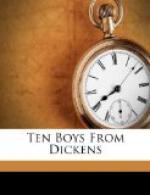I spent the night with Uncle Pumblechook, and the next morning we started off for Miss Havisham’s, and within a quarter hour had reached the house, which looked dismal, and had a great many iron bars to it. Some of the windows had been walled up, and the others were rustily barred. There was a court-yard in front which was also barred, so after ringing the bell we had to wait until some one should open it. Presently a window was raised and a voice asked “What name?” to which my conductor replied, “Pumblechook.” Then the window was shut, and a very pretty, proud-appearing young lady came down with keys in her hand. She opened the gate to let me in, and Uncle Pumblechook was about to follow, when the young lady remarked that Miss Havisham did not wish to see him. She said it in such an undiscussible way that Uncle Pumblechook dared not protest, and so I followed my young guide in alone and crossed the court-yard. We entered the house by a side door—the great front entrance had chains across it—and we went through many passages, and up a staircase, in the dark except for a single candle. At last we came to the door of a room, and she said, “Go in.”
I answered, more in shyness than politeness, “After you, miss.” But she answered, “Don’t be ridiculous, boy; I am not going in,” and scornfully walked away, and what was worse, took the candle with her.
This was most uncomfortable, and I was half afraid. However, there was only one thing to be done, so I knocked at the door, and was told from within to enter. I entered and found myself in a pretty, large room, well lighted with wax candles. No glimpse of daylight was to be seen in it. It was a dressing-room, as I supposed from the furniture, though much of it was of forms and uses quite unknown to me then. But prominent in it was a draped table with a gilded looking-glass, and that I made out to be a fine lady’s dressing-table.
In an arm chair sat the strangest lady I have ever seen or shall ever see. She was dressed in rich white—in satin and lace and silks—all of white. Even her shoes were white, and she had a long white veil dependent from her hair, and bridal flowers in her hair,—and the hair, too, was white. Some bright jewels sparkled on her neck and hands and others lay sparkling on the table. Dresses, less splendid than the one she wore, and half-packed trunks, were scattered about. She had but one shoe on and the other was on the table near by—her veil was but half arranged; her watch and chain were not put on; and there were lace, trinkets, handkerchief, gloves, some flowers, and a Prayer-book in a heap before the looking-glass. Then she spoke, “Who is it?”
“Pip, ma’am.”
“Pip?”
“Mr. Pumblechook’s boy, ma’am. Come—to play.”
“Come nearer; let me look at you. Come close.”
When I stood before her, avoiding her eyes, I took in all the details of the room and saw that her watch and clock had both stopped.




